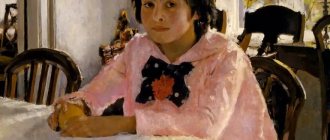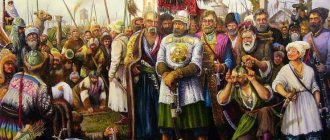Essay based on Makovsky’s painting “Date”
In the famous painting “Date” by V. E. Makovsky, created in the second half of the 19th century, we see a boy of about ten and his mother.
Their figures are clearly depicted in the foreground. A woman came on a date with her son, whom she probably had not seen for a very long time. Judging by her appearance, she is a simple peasant woman: she is wearing a simple black sheepskin coat, a scarf tied in a rustic manner, and the edge of a red skirt is visible below.
She most likely came from afar, on foot. Next to her, the artist depicted a small dusty bundle and a staff.
note
Her son was apparently sent to the city to learn a trade. He works in some workshop. This can also be seen from the way the boy is dressed. He is wearing a dirty, oily apron and an old, faded shirt. He stands barefoot and greedily eats the kalach his mother brought. The boy holds the bread tightly with both hands and it is clear that he is hungry.
It is easy to understand that life for both mother and son is unsweetened and poor. You have to work a lot and hard, but there is still little money. It was because of poverty that the child was given away to strangers so early. There are probably still small children left at home in the village, and it is very difficult for their parents to feed them all.
In those times depicted by V. E. Makovsky, children from poor families often lived in someone else’s house as servants or apprentices. They were often given the dirtiest and hardest work, they were beaten, and they were poorly fed. Of course, with such a life, the guys often got sick and even died.
Probably, the mother shown here went to the distant city primarily to make sure that her son was alive and well, to feed and caress him. But the woman has a lot to do at home, and the boy must return to work, and therefore they will soon be separated again for a long time.
The position of the characters in this picture is, as it were, emphasized by the wretchedness of the room in which their short meeting takes place. It's dirty and half empty. I think this is the room where workers usually rest and have lunch. There is a wooden barrel in the corner, and on it is a drinking jug. Through a small window sunlight falls on mother and son. He seems to be rejoicing at their long-awaited meeting.
While the boy is eating, the mother silently looks at him and thinks about something. It is clear from the expression on her face that her thoughts are sad. The peasant woman feels sorry for her son - tired, poorly dressed and hungry - to tears. She imagines how difficult it is for him in a big and unkind city. What’s especially hard is that she can’t help him in any way.
The mother probably wants to take her son home, but this cannot be done, because then they will have nothing to live on. The mother's heart is literally torn into pieces from love, pity and the inability to change anything. These dramatic feelings are very well conveyed by the author of the picture. These are the ones I consider to be the main ones here. In the everyday story of V.E.
Makovsky truthfully and talentedly showed the problems of the people of his time.
(2
Source: https://schoolessay.ru/sochinenie-po-kartine-makovskogo-svidanie/
Painting by Makovsky Date. 1883
V. Makovsky
Serfdom is already a thing of the past, but for the ordinary Russian person nothing changes. Makovsky's painting Date - painted in 1883, and is a striking example of Russian painting.
Like most of the artist’s other works, it is dedicated to the difficult life of peasants during that era. Peasants still have to work for landowners for pennies, and they send their sons to study in city workshops. But, once in someone else’s family, life is extremely difficult for children. Separated from their families, and still poor - they barely get by from day to day, work until exhaustion, and are constantly malnourished.
It is these aspects of life that Makovsky describes. On a small canvas the creator depicts an entire era. We see two nameless characters: a teenage child, and his mother, who has come to visit her son. We don't know who these characters are, but we understand that they can be recognized as most of the families of that time. The characters are ingrained in the memory, leaving a mark on the viewer’s soul: we worry about the fate of these people, but we understand that we cannot help. And this makes me so sad...
A fair-haired boy, barefoot, in dirty, ragged clothes, greedily pounces on the bread that his mother brought. We see that he is just a teenager, but life has left a heavy imprint on him. His face, beaten by fate, concentrated, sad... This is not the face of a boy, this is the face of a thirty-year-old man. Too early this child learned the difficulties of a poor life.
Sitting next to him is his mother, who, apparently, came to him from afar. The trace of a difficult fate on her is no more difficult to read than on her son. Dressed in a simple peasant dress and scarf, she came to the city, having with her only a small bundle in which she brought treats to her son. Her eyes express incredible melancholy, sadness, and pain... We understand that she simply cannot be old. But it is simply impossible to guess a woman's age. Too many trials befell her fate. Despite her exhaustion from life, and the fact that she is still young and in the body of a woman, her eyes are no longer young. These are the eyes of an old woman.
These two characters don't even look at each other. Perhaps not a single word was said during the meeting. And why? They are connected by the same fate, they do not have to express in words feelings that are already crystal clear. They are united by similar life circumstances, poverty. When looking at the canvas for a long time, tears appear in the viewer’s eyes. We can only hope that we will not see such families again. Hope and do everything necessary so that such family problems never exist on our land
At the moment, Makovsky’s painting “Date” is in the State Tretyakov Gallery, its size is 40 * 31 centimeters.
An essay based on a painting by V.E. Makovsky "Date"
A very warm and touching picture by V.E. Makovsky, it touches the depths of the soul, where it is common for a person to hide tenderness, placing it in the rank of weak qualities. “Date,” on the contrary, proves how strong love is, and therefore necessary and vital for everyone. Here the peculiarity of maternal feeling is glorified. But you can also learn a lot from the image of a child.
What details of the picture were interesting to me? For a long time I could not tear myself away from my mother’s face. It seems that this is not an old woman yet. But life broke her. She's not just sad, she's tired. Caring for everyone and everything made her despondent, with eyes sad from pain. She can't help but think and care about her son.
Life happened in such a way that she was forced to give him an apprenticeship. Thinking about his future, so that her own child would have a profession, and therefore a piece of bread, she was forced to tear him out of his usual environment. Even the plant gets sick when it is replanted. The mother deliberately deprived her son of her home, of her love, which she can now only give in fits and starts.
Important
She understands that her little child is now living in cold and hunger. And as best she can, she tries to take care of him. And now another meeting is depicted. Each of them misses each other, they have something to talk about, they want to say a lot. They want to hug and feel warmth. But now there is neither time nor opportunity.
Only the expression on the mother’s face tries to convey all the accumulated warmth and pain.
The master of the portrait depicted a woman of great strength and glory, described by poets as capable of doing various things, and even feats, helpless. This is the moment when she is unable to change anything. At the same time, the baby’s appearance does not at all indicate his ability to work hard physically.
And only a doomed and stubborn look says that he has taken the path of suffering and is ready to go to the end, no matter what the cost. Now he is barefoot and hungry, in torn clothes and afraid to even look up at his loved one, lest he burst into childish tears. But he will endure everything. And someday he himself will be a master. Now he promises himself this, otherwise he won’t be able to stand it.
He also promises that he will never be as cruel as his master. He will respect workers and students, and will not allow them to go hungry. Will it happen? Hardly. When he becomes an adult, the weight of his childhood will make his soul coarser and more callous. The mother looks at him and seems to understand all this and sees with her maternal instinct.
And she is sad that her child is doomed to misfortune, no matter what. There is no miracle that will fix this. And she is very, very sorry for him.
Thank you very much to the painter who so simply depicted the images, and at the same time, outlined the path to true happiness - this is love and kindness. Otherwise it won't work.
Source: https://isoch.ru/makovskii_v_e/153-ve-makovskogo-svidanie.html
Essay based on the painting by V. E. Makovsky “Date”
Essay based on the painting by V. E. Makovsky “Date”
Vladimir Egorovich Makovsky is a talented Russian painter of the mid-19th - early 20th centuries. The artist created genre works, each of which is a sketch of people's real lives. Makovsky paid special attention to the depiction of ordinary people and peasant life.
On his canvases we see humble and poor people, we better understand their troubles and sorrows. Each painting by a great artist is not just a fragment from life, it is a unique literary work that can be “read”. In fact, Makovsky more than once compared the art of painting and the power of the literary word.
Advice
In his opinion, it is necessary to make the reader and viewer empathize with the characters depicted in the picture or described in a literary work. The artist himself believed that a painting can be called completed only when there is real life in it.
For Vladimir Yegorovich, the everyday landscape was of particular interest, which made it possible to convey the mood, show and emphasize the most important things. The works of the great artist reflect an entire era.
The painting “Date” was created in 1883. This work can be called characteristic of Russian painting. The drama of the situation is obvious. In the picture we see a meeting between mother and son. Most likely, they have not seen each other for a long time. The boy was apprenticed. He is already old enough to leave his home and study some profession.
Essay on the painting “Date” by Makovsky: about the painting and not only about it
Let's preface the story about how to write an essay on the painting “Date” by Makovsky with some information about the artist and the time when the painting was created.
V. E. Makovsky and the Itinerant artists
Vladimir Egorovich Makovsky is a famous Russian artist, a representative of the Association of Traveling Art Exhibitions. The masters working in this association defended principles in their work that were opposite to artistic academicism. They advocated critical realism in art; their canvases were imbued with motifs of real life and features of everyday life, and not with pseudo-folk and mythological scenes, which were still valued at the Academy of Arts.
In the essay on the painting “Date” by Makovsky, we will say that the work was painted in 1883, during the period that is considered to be the heyday of the artist’s work.
Thematically, the works of most Peredvizhniki artists are characterized by so-called genre scenes, which reflected the real life of the people in all forms and in all social strata. We find such a democratic approach in most of Makovsky’s paintings.
Color scheme and plot of the picture
In an essay on the painting “Date” by Makovsky, we will describe the general color scheme of the painting. The canvas is designed in rather gloomy colors. The meeting of mother and son apparently takes place in the hallway in front of the workshop. The floors are stone, the walls are made of rough boards of different colors. There is a barrel with a drinking jug - workers probably come here to freshen up.
Hero clothing
The boy was sent to be trained by some artisan. At that time, many peasant families did this - here the boy not only received at least some pennies, but also the professional skills necessary for future work. True, as we remember from the stories of Chekhov and Gorky, children given “to the people” were often used as servants, lackeys, and nannies in the household. But the boy depicted in the picture is busy in a common task: he is wearing a stained apron, his shirt sleeves are rolled up, he is barefoot.
His family is probably very poor - the boy is dressed in pants and a shirt that are clearly too big for him, from someone else’s shoulder. The pants are rolled up, the shirt is gathered on the shoulders. Tired face, bags under the eyes. He greedily eats the bun brought by his mother.
But next to him is his mother. Or rather, we don’t know for sure whether she is the boy’s mother. But from her face - compassionate and submissive to her sorrowful lot - we understand this. The woman’s face seemed frozen in its everyday misfortune and poverty, she felt sorry for her son, she didn’t know how long he would survive, working so hard and eating so poorly. But there is nothing to do - we must endure. And then, you see, God will help. There is no other way out. The whole pose of this woman tells us about her hopelessness. This is how ordinary Russian people reasoned, and this is how the artist shows us.
Both characters, as it should be noted in our short essay on Makovsky’s painting “Date,” are drawn with special care. We see that the mother is dressed in outerwear, a scarf is tied on her head, and a bundle lies at her feet - which means that in order to visit her son, she had to travel quite a distance. Ordinary people, if they happened to go somewhere on foot, used to often carry a knapsack on a stick, which they placed on their shoulder. This stick could also be used as a staff. This was usually done in villages - which means, we think, that the boy’s family most likely lives in the village.
General impression
In conclusion of the essay on the painting “Date” by V. E. Makovsky, let’s talk about what, in our opinion, the painting lacked. She lacked real tragedy. A real grief could be a childhood shackled in poverty - but such that the viewer really feels that this is childhood. That a child still remains a child, even when he is seriously ill, and when he is tired, and when he is hungry. The boy from Makovsky’s painting is simply an exhausted little creature. It is a social element of its environment. The artist diligently painted portraits of the child and his mother so that the audience would be imbued with the misfortune of the heroes. But it is unlikely that the master himself, who grew up in a wealthy, intelligent family of artists, where they never knew hopeless poverty and the struggle for existence, could be so compassionate as to show us all the bitterness of the scene he painted.
Essay based on Makovsky’s painting “Date”
V.E. Makovsky is one of the best artists of the 19th century. With his paintings, the author forced people to think about the problems that were relevant at that time.
Most of his works depict one or another situation that reflects the realities of his time. One of his best paintings is called “Date”.
Let's figure out what it depicts and why it is considered one of the best in his work.
In the foreground are the main characters: mother and son. They had not seen each other for a long time and finally met.
You can see from the mother's eyes how happy she is to see her son.
Apparently, she had come a long way to meet him. The artist focuses the viewer's attention on the cane and the dust bag. We understand that the woman is sick, but she is still ready to do anything to meet her child.
Her nose is red from the cold, but she is still happy to see her child.
The son greedily bites into the bun that his mother brought him. The boy is completely focused on eating. There is nothing surprising. At the end of the 19th century, children often left home at a young age to work part-time. Most often, they became apprentices - helping the masters with the most difficult work. They carried heavy objects and did all the housework. This often led to death.
The fact that it is difficult for a boy can be judged by his appearance. His clothes are all covered in dust. It can be seen that it is old and worn out. Plus, he's barefoot. It must be incredibly difficult for him in the cold seasons.
You can see sadness in the mother's eyes. This is not surprising, because, most likely, she herself sent the san to work part-time. She could take him, but then their family would not have the means to feed themselves.
With this simple picture V.E. Makovsky raises the problem of peasant poverty in the 19th century. Despite the abolition of serfdom, life did not become easier for the population. There wasn’t even enough money for food, let alone clothes. Everyone survived as best they could. Some tried to make money by growing food in their gardens. Some went to the city to earn money.
Also, the main character of the film earns money through menial labor for the sake of his family. He gave up his happy childhood for the well-being of his loved ones.
Advice
The place where the heroes meet looks like a workers' break room. It's dirty and dark. All it contains is a jug of water to quench your thirst. The window is very small, so there is little light in the room.
The whole picture is painted in dark colors, which sets the desired atmosphere. The viewer empathizes with the heroes, because they realize that perhaps the heroes will not meet soon. It is becoming increasingly difficult for a mother to visit her son. A boy can be ruined by hard work at any moment.
To summarize, I would like to say V.E. Makovsky is a real genius. With a couple of movements of the brush, he is able to create a canvas that will make the heart of any person flutter. Despite the gloominess of the painting “Date,” it deservedly has the title of a masterpiece of Russian painting. It is difficult to watch the meeting of a sad mother with her hungry son without tears.
Source: https://sochinyalka.ru/2017/03/sochinenie-po-kartine-svidanie.html
Essay on the painting Makovsky's Date 4, 7th grade
Back in 1883, Vladimir Makovsky painted a beautiful painting called “Date.”
It contained the theme of impoverishment and suffering of the poor people, as well as the care and power of maternal love. The canvas depicts the long-awaited meeting of a mother and son, who, by coincidence, live far from each other, since the mother sent her son to work as an apprentice in the city because there was not enough money to exist.
The woman is dressed simply, an ordinary sheepskin coat from under which part of a red dress peeks out, her head is covered with a woolen scarf, this indicates that winter reigns in the yard.
The son, on the contrary, is dressed in a simple shirt, over which is thrown a work apron. The feet are bare and crippled. He eats the kalach that his mother brought him, and eats it with greed and some kind of renunciation of what is happening.
The mother’s pose shows how tired she is from the long journey, and her gaze reflects sincere tenderness and love towards her child. She wants to hug him, but she doesn't dare stop him from eating. He wants to admire his child, because it is unknown whether they will see each other again or not. A half-empty knapsack and a cane indicate to us that a woman spends a huge amount of effort and time on the way to her child.
The room in which this family is located also does not sparkle with wealth, but, on the contrary, preserves modest asceticism. A lonely jug of water, which stands on a rotten barrel, was most likely used by workers during short breaks, indicating how hungry and tormented people were during that difficult time.
The painting uses predominantly dark colors and tones. The only source of light is a small window, which allows us to see this simultaneously sad and long-awaited meeting.
The artist tried to convey to us the whole essence and tragedy of those times when people had to make tough choices in favor of the lives of their loved ones.
Description of the painting by Makovsky Date
The painting was painted at the end of the 19th century. It conveys the everyday life of poor peasants.
In the reproduction of the painting “Date” you can see the long-awaited meeting of mother and son. The main characters are depicted in the foreground: an elderly woman and her precocious child. The background is mixed from shades of dirty colors, creating a picture of a gloomy room.
From the woman’s sad look it is clear that she has not seen her child for quite a long time. She is dressed in several layers of clothing, which means that in the reproduction, outside the supposed “window,” it is winter. Her attire looks scanty and poor. Obviously, the unfortunate mother was walking from the village to meet her son. Due to her poverty, she was able to bring only one gift - bread.
Looking at the boy, you can see that he is wearing a special apprentice's work uniform. It becomes clear that he was sent to the city for training and lives away from his family. He humbly stands and is silent, eating his mother’s only gift, as if he is afraid that his delicacy will be taken away. The way he greedily eats bread means that he lives in poor conditions. His bare feet standing on the cold floor, dirty clothes and a stern, rough childish face show that, despite his young age, everyone considers him a full-fledged adult worker.
Judging by the dirty background, it is clear that their date is taking place in the workshop where the boy lives. In the foreground, next to the main characters, there is a dilapidated wooden barrel with a jug on it. Dirty rags for cleaning the room are scattered below. Judging by the lack of working equipment, it can be understood that the meeting is taking place in a common room. Daylight streams in from a barely noticeable window. It becomes clear that working conditions there are not the best, especially for a boy.
Such an abundance of darkness and blackness shows not only the polluted environment in the workshop, but also the feelings of the mother and son. The artist very accurately showed all the pain and bitterness reflected in the faces of the characters. Children are forced to move away from home at such a young age and live in darkness and filth. It is also clear what mothers are capable of for the sake of their “grown-up” children. Makovskikh perfectly conveyed not only the feelings of the peasants, but also their way of life. Dirty gloomy clothes on an adult woman, specially thrown over each other to keep warm. The boy's dirty face and uniform shows how even children of that time were treated.
Description of the mood of the painting Date
Popular topics today
Mikhail Vasilyevich Nesterov is a talented Soviet artist and painter. One of the participants in a unique partnership of traveling exhibitions, with the help of which at that time artists introduced simple
Konstantin Korovin is a magnificent artist of the 19th century. His main goal was to convey the beauty of the surrounding world.
The artistic creation is the last canvas of the painter, remaining unfinished, although its image is presented to the audience in the form of a completed picture.
More than anything else, Aivazovsky liked to paint not only the sea, but also different cities and countries. He often visited Turkey, which is why you can see this country in many canvases.
A.G. Venetsianov in his painting “On arable land. Spring" depicted a typical scene from peasant life - plowing a field. The artist masterfully conveyed the character traits of a Russian woman






